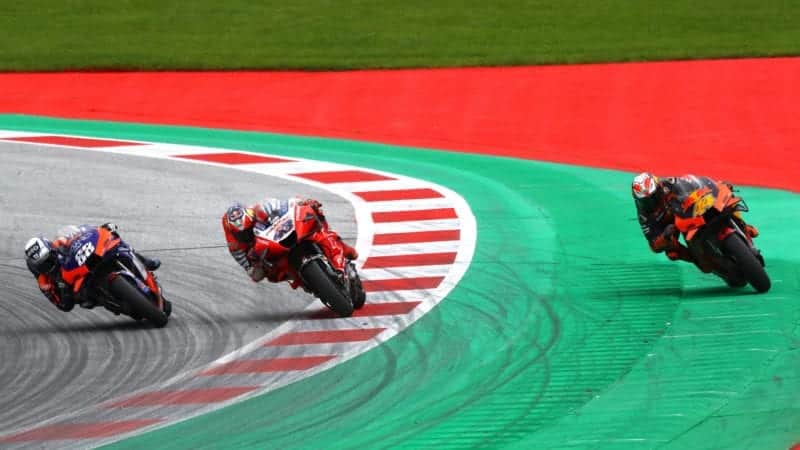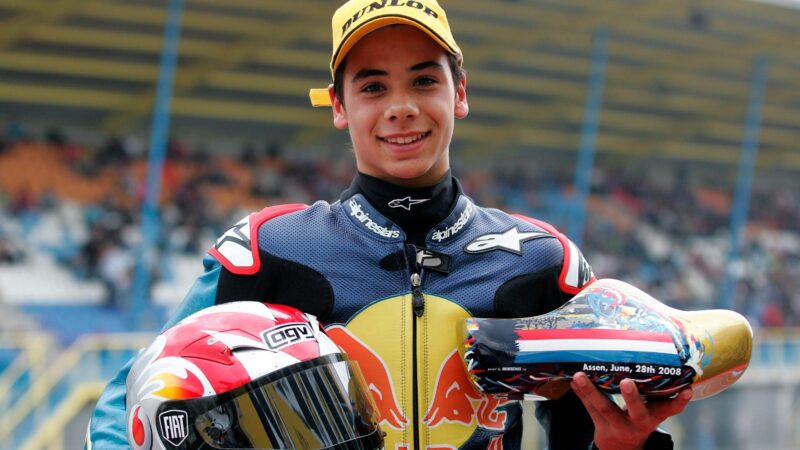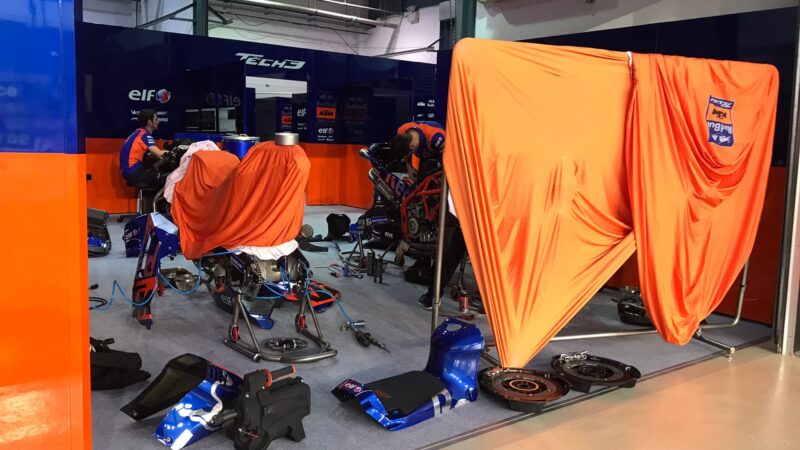Why MotoGP has gone wild – when the cat’s away…
The absence of Marc Márquez has opened up the MotoGP world championship and changed the psyche of half the grid

Green with envy – Sunday’s final-corner Miller/ Espargaró brawl opens the door for Oliveira #88
Red Bull
The last time the reigning MotoGP king got badly hurt was in 1999, when Mick Doohan suffered career-ending injuries at Jerez, coincidentally just metres from where fellow Repsol Honda rider Marc Márquez recently ended his hopes of matching Doohan’s five consecutive championship titles.
When the star is removed from the stage something happens to the other players – they see that place in the spotlight is empty and they are drawn towards it, like moths to the limelight.
Doohan always made a point of making sure that his rivals fully understood they had no hope of beating him to the championship. Márquez’s astonishing 2016, 2017, 2018 and 2019 seasons had the same effect on the current grid – their first thought was, who’s going to finish second?
When Doohan got hurt in May 1999 everything changed, because everyone thought they had a chance of winning the championship. That year there were six different race winners: Alex Crivillé, Kenny Roberts Jr, Tady Okada, Regis Laconi, Max Biaggi and Norick Abe. And without Doohan around to force the pace the racing was so tight that both the closest podium finish of all time and the third closest were recorded in 1999: at the Australian GP, where 0.124sec covered Okada, Biaggi and Laconi, and at Rio, where 0.257sec covered Abe, Biaggi and Roberts Jr.
We are now back in 1999: the cat is away and the mice are at play (with no disrespect to the mice). Márquez’s absence has done something to the psyche of half the grid. Already there have been four different winners from five races, with surely many more to come, and machine performance is so equal that riders on five different makes of bike have the tools to win.
And when half the grid believes they can win the title, instead of dreaming of nothing better than second place, things get very lively, very quickly, which is one reason for all the accidents and incidents that have rocked MotoGP over the last three race weekends at Brno and Red Bull Ring.
It’s difficult to see the situation calming down until the last week of November. After the first five races of 2019 the top five were separated by 38 points. This year it’s just 22 points, so it’s any rider’s title and any factory’s title.
There was plenty of needle in Sunday’s top three alone; specifically from Miguel Oliveira and Jack Miller, who were both gunning for Pol Espargaró after disagreements following the previous Sunday’s Austrian GP.
Espargaró and Oliveira collided and crashed out of that race, sparking an angry war of words between the two KTM riders.
“If I was Pol,” said Oliveira before going back to work at the Styrian GP. “After two incidents with the same character [Espargaró had already clashed with Johann Zarco the weekend before at Brno] I would start to think if I am approaching racing in the right way, because at the moment that seems questionable.”
Miller had it in for Espargaró because the Spaniard had boasted how he would’ve won the Austrian GP, if it hadn’t been red-flagged following the Zarco/Franco Morbidelli pile-up.
“KTM do a lot of talking,” said the Pramac Ducati man. “Especially one of them, telling everyone they were going to win the race after it’d only gone eight laps.”
This kind of thing fires up riders. Always has done. Always will do.
There were several other factors in Oliveira’s last-corner victory. At the start of the last lap Espargaró’s bit-board told him “+0” when in fact he had three-tenths lead on Miller. Perhaps that panicked him into using a too-defensive line into Turn Three, which ran him wide on the exit, allowing Miller to use his draft, then out-brake the Spaniard into Turn Four. Espargaró counter-attacked at the penultimate corner but again ran wide, allowing Miller to get inside at the final turn, which pushed them both wide, leaving the door open for Oliveira to power past, no doubt laughing like he’s never laughed before as he accelerated towards the chequered flag.
KTM’s second MotoGP victory in just three weeks and its first double podium, with Miller’s Ducati in between, also made history. This was the first time in almost half a century that a premier-class podium didn’t feature a Japanese manufacturer. The last time that happened was at the 1973 Swedish GP when aristocratic Italian marque MV Agusta took the first two places in front of a German-made Konig, which was basically an outboard motor with wheels.

Oliveira after winning the 2008 Red Bull Rookies Race at the Dutch TT
Red Bull
Oliveira didn’t come from nowhere
Miguel Oliveira never won a world title on his way to getting his place on the MotoGP grid, so in some ways, Portugal’s first MotoGP winner has risen to greatness under the radar.
Oliveira was a MotoGP rookie last year and yet he impressed in his very first race aboard KTM’s hard-to-manage 2019 RC16. Those who had their eyes on what was happening behind the Andrea Dovizioso/Marc Márquez duel for victory noted that Oliveira led fellow KTM rider Pol Espargaró for most of the Qatar GP. And next time out in Argentina he finished 11th, in the slipstream of Espargaró, who was starting his sixth season in the premier class.
At Red Bull Ring last August, Oliveira scored his first top-ten MotoGP result, only to be taken out by Johann Zarco next time out at Silverstone, sustaining a nasty shoulder injury that required surgery.
Like many motorcycle racers, he is the son of a motorcycle racer, Paolo, who now runs a racing school. Once Oliveira had cleaned up in Portugal he crossed the border into Spain, where he battled with Álex Rins, Maverick Viñales and other up-and-comers. A ride in the Red Bull Rookies Cup followed, then his Grand Prix debut in 2011. He made his name in Moto3, doing the hard yards aboard the Mahindra in 2013 and 2014, but his talent shone through, attracting the attention of kingmaker Aki Ajo, boss of Red Bull KTM’s Moto2 and Moto3 teams, which coach youngsters towards stardom.
In 2015 Oliveira came within six points of beating Danny Kent to the Moto3 world title, even though Kent’s Honda was quicker than Oliveira’s KTM. Three years later, still with Ajo, he finished nine points behind Pecco Bagnaia in the Moto2 championship.
Like Czech GP winner Brad Binder he is a product of the Red Bull KTM production line: Red Bull Rookies, Ajo’s Moto3 and Moto2 squads and finally Red Bull KTM’s MotoGP project.
The 25-year-old is the new Andrea Dovizioso: highly intelligent, very thoughtful and cool, calm and collected. This is the attitude you need to succeed in MotoGP. And just like Dovizioso, he crashes very rarely – collisions excluded – because he knows when it’s worth taking risks and when it’s better to stay healthy and wait for better times.
“In MotoGP you have to approach the bike differently,” he says. “In Moto3 you can overcome your speed by following someone. Moto2 is more difficult because the slipstream doesn’t have a big effect on lap times, but it’s hard in other aspects. In MotoGP the bike limits you more, especially in the settings. The human factor in MotoGP is big, but the machine counts for more than in the other classes. But I like it a lot, because I always want to understand what is going on with the motorcycle, the track, everything.”
Oliveira’s style is smooth and controlled – he looks totally different on the RC16 to Espargaró and Binder. “I think I’m smooth on the bike, maybe too much,” he says.
Sunday proved that the RC16 can be ridden to victory either way. It really is the best bike on the grid at the moment. After five races the Austrian factory is third in the constructors title race, just five points behind Ducati and six behind Yamaha, still ahead despite a disastrous two races at Red Bull Ring.
Red flags are always anguish for some riders and sometimes a joy to behold for others. On Sunday Oliveira was happy to see the red flag following Maverick Viñales’ fiery accident. He had started the race with the medium-option front, which he soon knew was a mistake, because he couldn’t go with the lead group.
The restart allowed him to switch to a hard front, which is the 2020 RC16’s preferred front tyre, then take advantage when Miller and Espargaró clashed at the final corner.

Chaos in the Tech 3 garage at Qatar 2019, the team’s first race with the KTM RC16
Mat Oxley
Oliveira’s joy and KTM’s joy was also Tech 3’s joy and Guy Coulon’s joy. The French team, owned by Herve Poncharal, graduated to the premier class in 2001 and yet Sunday’s last gasp victory was its first in the category.
At the start of last season several people in the team – including senior management – seriously doubted they had made the right decision when they signed a long-term deal with KTM. At the first few races, the Tech 3 pit was chaotic as technical staff struggled to get to grips with the RC16, a very different motorcycle to Yamaha’s YZR-M1, which they had campaigned since 2003.
Tech 3’s Red Bull Ring victory was its first success since the team won the 250cc world title in 2000 with Olivier Jacque, who might’ve won Tech 3’s first big bike GP aboard a Yamaha YZR500 at Sachsenring the following summer if he hadn’t been taken out of the lead in the final laps. That would’ve been a historic victory – the only time the 500cc two-strokes beat the brand-new 990cc four-strokes – but it was not to be.
Oliveira’s crew chief Coulon is one of the paddock’s longest-serving engineers – he has worked in GPs for 35 years. Before Oliveira, the French pit-lane wizard worked with Jacque, Johan Zarco, Andrea Dovizioso, Bradley Smith, Carlos Checa, Colin Edwards and Dominique Sarron.
It’s worth noting that KTM is the only top factory that has recently tested at Misano, venue for the next two races, which should give its riders an advantage. KTM visited the track in June, trying out the new surface in one of the brand’s last opportunities to enjoy its testing concessions. Following Sunday’s double podium KTM’s MotoGP teams are no longer allowed to go testing whenever they desire.

